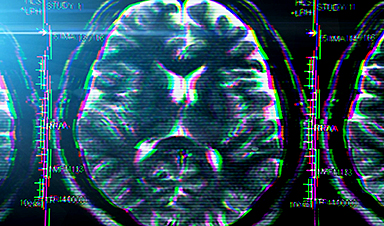Research from the University of Washington revealed that COVID-19 lockdowns led to accelerated cortical thinning in adolescents, impacting brain development significantly.
This effect was more pronounced in females than males, raising concerns about long-term brain health. The study highlights the importance of social interactions during adolescence, a period critical for cognitive development and mental health, especially as social restrictions have exacerbated conditions like anxiety and depression among teenagers.
Impact of Lockdowns on Adolescent Brain Development
A recent study reported the somewhat alarming findings that the social disruptions of COVID-19 lockdowns caused significant changes in teenagers’ brains.
Researchers at the University of Washington in Seattle used MRI scans to examine the adolescent brain’s cortex — the folded outer layer responsible for complex thinking. They discovered that the typical age-related thinning of the cortex accelerated after the lockdowns, with girls showing more pronounced changes than boys.
What do these findings mean?
Science highlights adolescence as a critical stage for brain development. Many typical teenage behaviors stem from the brain cortex still maturing. During this period, key developmental processes occur, including the thinning of the cortex, which helps the brain become more efficient and better organized.
Groundbreaking research published in 2022 provided the first evidence of a crucial window of brain “plasticity” — its ability to adapt — in the frontal brain region. This area is essential for functions such as decision-making, problem-solving, short-term memory, and managing social behavior.

Given the evidence of this sensitivity of brain development in adolescence, is it possible that the pandemic lockdowns really did accelerate harmful brain aging in teenagers? And how strong is the evidence that it was due to the lockdowns and not something else?
To answer the first question, we have to realize that aging and development are two sides of the same coin. They are inextricably linked. On the one hand, biological aging is the progressive decline in the function of the body’s cells, tissues, and systems. On the other, development is the process by which we reach maturity.
Adverse conditions at critical periods of our life, especially adolescence, are very likely to influence our aging trajectory. It is therefore plausible that the “accelerated maturation” of the teenage brain cortex is an age-related change that will affect the rate of brain aging throughout life.
So it seems there is an unpalatable and much more serious conclusion: the reported accelerated maturation – though serious enough – is not a one-off detriment. It may well set a trajectory of adverse brain aging way beyond adolescence.
The Role of Social Interaction in Brain Health
Now to the second question: the role, if any, of the lockdowns. One of the central pillars of brain health is “social cognition”: the capacity of the brain to interact socially with others. It has been embedded in our brains for 1.5 million years. It is not an optional add-on. It is fundamentally important. Interfere with it and potentially devastating health consequences result, particularly in adolescents who depend on social interaction for normal cognitive development.
At the same time, adolescence is also a period of the emergence of many neuropsychiatric disorders, including anxiety and depression, with younger females at a higher risk of developing anxiety and mood disorders than males.
Devastating Consequences
The socially restrictive lockdown measures appear to have had a substantial negative effect on the mental health of teenagers, especially girls, and the new study provides a potential underlying cause.
There is little doubt that the pandemic lockdowns resulted in devastating health consequences for many people. To the litany of evidence, we may now add a particularly grim finding – that the developmental brain biology of our precious teenage population has been damaged by these measures.
But perhaps the main message is that the wider effects of single-issue health policies should be considered more carefully. In the case of the known damaging effects of social isolation and loneliness on brain health, it’s not as if the evidence wasn’t there.
Written by James Goodwin, Professor in the Physiology of Ageing, Loughborough University.
Adapted from an article originally published in The Conversation.
Reference: “COVID-19 lockdown effects on adolescent brain structure suggest accelerated maturation that is more pronounced in females than in males” by Neva M. Corrigan, Ariel Rokem and Patricia K. Kuhl, 9 September 2024, Proceedings of the National Academy of Sciences.
DOI: 10.1073/pnas.2403200121
News
Repurposed drugs could calm the immune system’s response to nanomedicine
An international study led by researchers at the University of Colorado Anschutz Medical Campus has identified a promising strategy to enhance the safety of nanomedicines, advanced therapies often used in cancer and vaccine treatments, [...]
Nano-Enhanced Hydrogel Strategies for Cartilage Repair
A recent article in Engineering describes the development of a protein-based nanocomposite hydrogel designed to deliver two therapeutic agents—dexamethasone (Dex) and kartogenin (KGN)—to support cartilage repair. The hydrogel is engineered to modulate immune responses and promote [...]
New Cancer Drug Blocks Tumors Without Debilitating Side Effects
A new drug targets RAS-PI3Kα pathways without harmful side effects. It was developed using high-performance computing and AI. A new cancer drug candidate, developed through a collaboration between Lawrence Livermore National Laboratory (LLNL), BridgeBio Oncology [...]
Scientists Are Pretty Close to Replicating the First Thing That Ever Lived
For 400 million years, a leading hypothesis claims, Earth was an “RNA World,” meaning that life must’ve first replicated from RNA before the arrival of proteins and DNA. Unfortunately, scientists have failed to find [...]
Why ‘Peniaphobia’ Is Exploding Among Young People (And Why We Should Be Concerned)
An insidious illness is taking hold among a growing proportion of young people. Little known to the general public, peniaphobia—the fear of becoming poor—is gaining ground among teens and young adults. Discover the causes [...]
Team finds flawed data in recent study relevant to coronavirus antiviral development
The COVID pandemic illustrated how urgently we need antiviral medications capable of treating coronavirus infections. To aid this effort, researchers quickly homed in on part of SARS-CoV-2's molecular structure known as the NiRAN domain—an [...]
Drug-Coated Neural Implants Reduce Immune Rejection
Summary: A new study shows that coating neural prosthetic implants with the anti-inflammatory drug dexamethasone helps reduce the body’s immune response and scar tissue formation. This strategy enhances the long-term performance and stability of electrodes [...]
Scientists discover cancer-fighting bacteria that ‘soak up’ forever chemicals in the body
A family of healthy bacteria may help 'soak up' toxic forever chemicals in the body, warding off their cancerous effects. Forever chemicals, also known as PFAS (per- and polyfluoroalkyl substances), are toxic chemicals that [...]
Johns Hopkins Researchers Uncover a New Way To Kill Cancer Cells
A new study reveals that blocking ribosomal RNA production rewires cancer cell behavior and could help treat genetically unstable tumors. Researchers at the Johns Hopkins Kimmel Cancer Center and the Department of Radiation Oncology and Molecular [...]
AI matches doctors in mapping lung tumors for radiation therapy
In radiation therapy, precision can save lives. Oncologists must carefully map the size and location of a tumor before delivering high-dose radiation to destroy cancer cells while sparing healthy tissue. But this process, called [...]
Scientists Finally “See” Key Protein That Controls Inflammation
Researchers used advanced microscopy to uncover important protein structures. For the first time, two important protein structures in the human body are being visualized, thanks in part to cutting-edge technology at the University of [...]
AI tool detects 9 types of dementia from a single brain scan
Mayo Clinic researchers have developed a new artificial intelligence (AI) tool that helps clinicians identify brain activity patterns linked to nine types of dementia, including Alzheimer's disease, using a single, widely available scan—a transformative [...]
Is plastic packaging putting more than just food on your plate?
New research reveals that common food packaging and utensils can shed microscopic plastics into our food, prompting urgent calls for stricter testing and updated regulations to protect public health. Beyond microplastics: The analysis intentionally [...]
Aging Spreads Through the Bloodstream
Summary: New research reveals that aging isn’t just a local cellular process—it can spread throughout the body via the bloodstream. A redox-sensitive protein called ReHMGB1, secreted by senescent cells, was found to trigger aging features [...]
AI and nanomedicine find rare biomarkers for prostrate cancer and atherosclerosis
Imagine a stadium packed with 75,000 fans, all wearing green and white jerseys—except one person in a solid green shirt. Finding that person would be tough. That's how hard it is for scientists to [...]
Are Pesticides Breeding the Next Pandemic? Experts Warn of Fungal Superbugs
Fungicides used in agriculture have been linked to an increase in resistance to antifungal drugs in both humans and animals. Fungal infections are on the rise, and two UC Davis infectious disease experts, Dr. George Thompson [...]





















